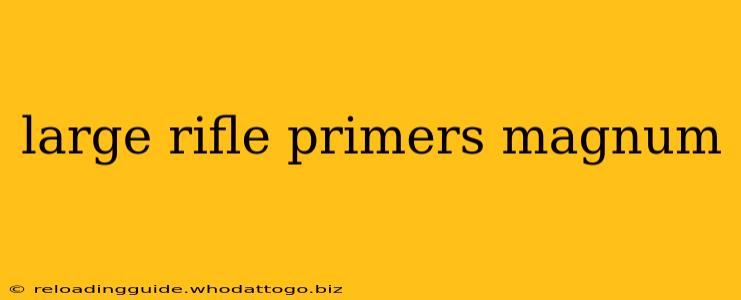Large rifle magnum primers are a crucial component for serious handloaders, particularly those working with powerful cartridges or challenging conditions. Understanding their characteristics and applications is essential for safe and reliable reloading. This guide delves into the specifics of large rifle magnum primers, exploring their uses, advantages, and potential drawbacks.
What Makes a Magnum Primer "Magnum"?
The term "magnum" signifies a primer with increased sensitivity and a more substantial charge of primer mixture. This translates to a more powerful ignition, which is particularly beneficial in several scenarios:
-
High-pressure cartridges: Magnum primers are often necessary for cartridges known for their high pressures, ensuring consistent ignition even under demanding conditions. These cartridges require a reliable and robust ignition to prevent squib loads or incomplete burning of the propellant.
-
Cold weather shooting: Lower temperatures can affect the ignition sensitivity of standard primers. Magnum primers offer a more reliable ignition even in frigid conditions, reducing the risk of misfires.
-
Hard-to-ignite powders: Some propellant powders are inherently more difficult to ignite than others. Magnum primers provide the extra "oomph" needed to ensure consistent ignition and complete burning of these slower-burning powders.
-
Reduced primer pockets: Primers with a stronger cup strength are recommended for cases with softer or more easily damaged primer pockets to prevent deformation during firing. This is crucial to consistent headspace and safety.
Choosing the Right Large Rifle Magnum Primer
Several manufacturers produce large rifle magnum primers, each with its own unique characteristics. While the core functionality remains the same—increased sensitivity and power—subtle variations exist. Factors to consider include:
-
Primer brand and consistency: Different manufacturers may have slightly different performance characteristics. Sticking to a single brand for consistent results is often recommended.
-
Cartridge specifications: Always refer to the reloading data specific to your chosen cartridge and projectile before selecting a primer. Using the wrong primer can lead to dangerous over-pressure conditions.
-
Environmental conditions: Consider the temperature range in which you’ll be using the ammunition. If consistently shooting in cold weather, magnum primers offer a significant advantage.
Potential Drawbacks of Using Magnum Primers
While the benefits are clear, there are some potential drawbacks to consider:
-
Increased pressure: Magnum primers can result in slightly higher chamber pressures compared to standard primers. This is not necessarily dangerous, provided you stick meticulously to published loading data. However, it is a factor to take into account.
-
Not always necessary: In many cases, standard primers will provide completely adequate ignition. Using magnum primers unnecessarily can lead to unnecessary pressure increases without benefit.
Safety First: Reloading is Serious Business
Reloading ammunition requires precision, attention to detail, and a thorough understanding of safety procedures. Always:
- Follow published reloading data: Never deviate from the recommended loading data provided by reputable sources.
- Use appropriate safety equipment: Wear safety glasses and gloves when reloading.
- Inspect your ammunition: Carefully inspect each round before loading it into your firearm.
Large rifle magnum primers are a valuable tool for handloaders, providing increased reliability in challenging situations. However, understanding their characteristics and responsible usage is paramount. Always prioritize safety and adhere to published loading data to ensure a safe and enjoyable reloading experience.

